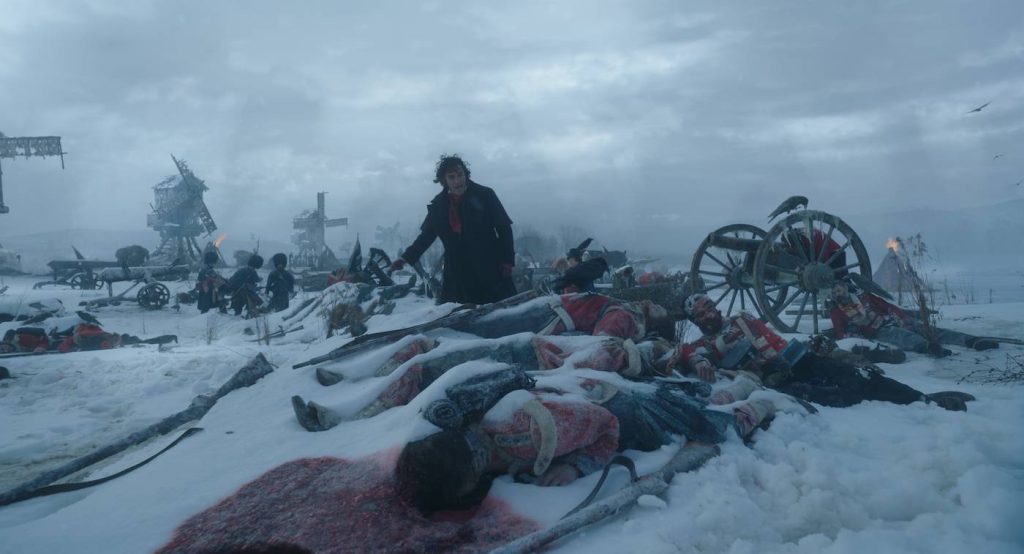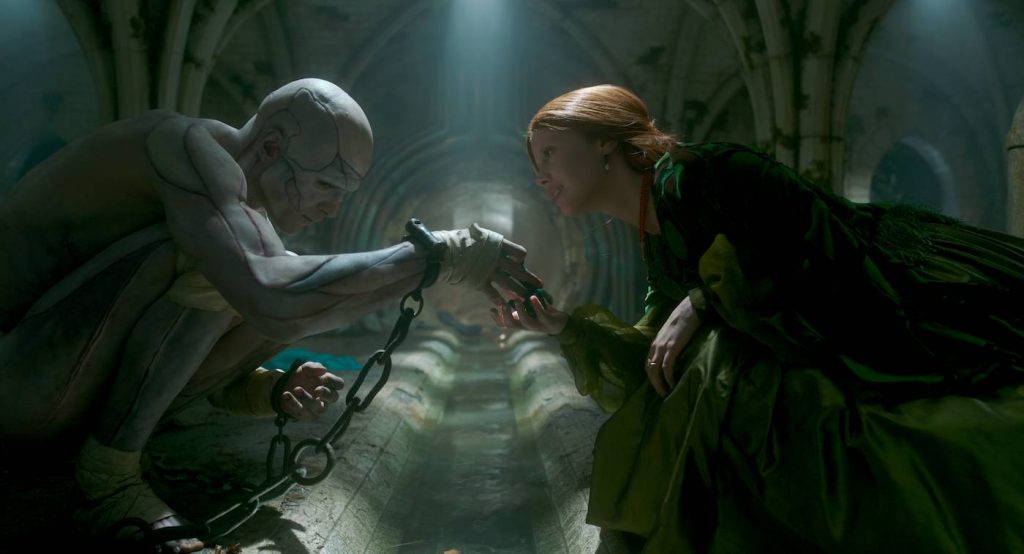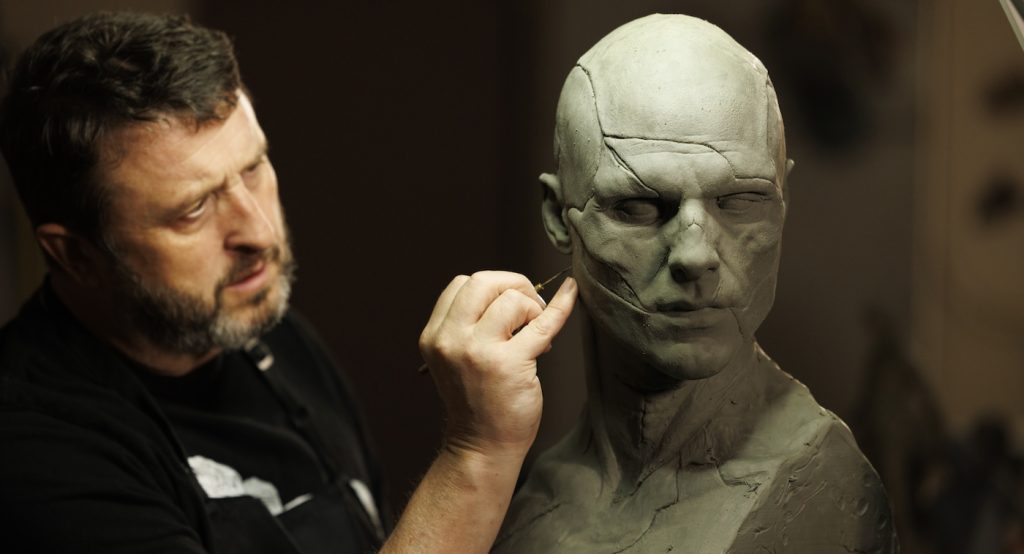42 Prosthetics, 10-Hour Nights: How Prosthetics Master Mike Hill Turned Jacob Elordi Into the Creature for Guillermo Del Toro’s “Frankenstein”
If ever a man were destined to design a new Frankenstein, it would surely be Mike Hill. The British-born prosthetics and makeup artist behind Guillermo del Toro’s new Frankenstein movie (in theaters now, streaming on Netflix starting November 7) remembers finding his calling at the age of five. “I’d walk to the river in the pouring rain with a little pail and a spade and I’d dig up the clay from deep in the riverbank, take it home, dry it out on the concrete,” Hill recalls. “Then I’d sculpt Frankenstein, I’d sculpt King Kong, I’d sculpt a menagerie of dinosaurs. And I realized ‘I can make monsters.’ Which, I guess, I still do.”
Hill eventually moved to Hollywood and worked on X-Men movies, followed by films from del Toro, including The Shape of Water and Nightmare Alley. Del Toro then enlisted Hill to lead the prosthetic makeup effects department for his lavish adaptation of Frankenstein, starring Jacob Elordi as The Creature and Oscar Isaac in the title role as Dr. Victor Frankenstein.
Speaking from his home in Los Angeles, Hill explains how he bonded with del Toro over Frankenstein statues and details the ten-hour makeup sessions that transformed Elordi into a “newly minted man.”
Tell us about Guillermo del Toro’s “Frankenstein room.”
At his house, Guillermo has a whole room dedicated to Frankenstein and a lot of my work is in there. I made statues of Boris Karloff’s giant Frankenstein head [from the 1931 movie], Karloff walking with little Maria [Marilyn Harris], Dr. Pretorius from The Bride of Frankenstein
How big are these sculptures?
They’re life-size. Guillermo likes to call them his friends and speaks to them every morning. The statues — they’re actually how we met.
What happened?
At a convention, Guillermo saw a [sculpture] piece I did, so then he did some serious “Colombo” [detective work]. He tracked me down through an old [internet] forum and emailed me. I was like, “Is this really you?” And it was. That’s when we realized we both had a passionate affair with [Frankenstein author] Mary Shelley. Guillermo commissioned me to do Boris Karloff’s monster in the makeup chair.

That’s some cute meet: “Please make me a life-size Frankenstein.” When del Toro got the green light to make this movie, what was his creative brief for the Creature?
Well, first, he told me what he didn’t want.
Which was…
He didn’t want Frankenstein’s creature to have all those stitches. I was in total agreement because, not to knock anybody else’s work, but I felt like a lot of times, Frankenstein looks like he’d been in a car accident, and somebody stitched him back together. Guillermo didn’t want that crudity, and neither did I. What I wanted was the feeling that when you see this Creature, you think, “This is not a repair job. This is a newly minted man.”

To get there, the actor Jacob Elordi obviously needed a lot of enhancements.
We had 42 [silicone] appliances that we put on Jacob’s head and body. It took ten hours a day to do the makeup. Our call time to start work was midnight.
Jacob Elordi is sitting in the chair for ten hours before he even gets to the set and starts acting?
And he never complained once.

While you’re applying the prosthetics, how did he pass the time?
We put old monster movies on to familiarize Jacob with the old Universal and [British Gothic horror studio] Hammer movies. Jacob’s a movie aficionado but wasn’t really horror-focused, so I wanted to open his eyes a wee bit and let him see Christopher Lee [as Dracula] up on the screen. It was very cool.
Del Toro’s version of the story shows Victor Frankenstein salvaging corpses from a battlefield during the Crimean War. How did that concept affect your approach to the Creature?
It meant that these fresh bodies would usually have only one injury. Maybe the hand got blown off or the foot’s missing, so there’d be surgery scars. That’s where all the cuts and nicks come from, not from sewing him together from other parts. Remember, Victor has never made a man before, so there are a lot of mistakes, a few too many cuts, and a few too many graftings. He’s experimenting as he goes, trying to make something better than him, which is why, I guess, the jealousy kicks in.

You also altered Elordi’s physique?
I gave him bigger trap muscles back here [pointing behind his neck] and bigger deltoids to broaden him up. Jacob had a fantastic swimmer’s body, but I wanted to give him more strength in the upper quarters.
Besides bulking up the Creature, you imbued him with an almost luminescent skin tone. What were you going for there?
Guillermo wanted oyster grey, so I put that in, but I also used blue, an homage to Karloff because [makeup artist] Jack Pierce used a blue-grey makeup. And some of it was yellow, because Mary Shelley wrote that the Creature’s skin was yellow. Then I painted in all these subtle hues of alabaster, purples, yellows, and reds that you normally wouldn’t think of using on Frankenstein. I put them in there because he sort of comes out like a butterfly, and then as the movie progresses and the world beats him down, the Creature becomes more like a moth, and the colors die down and get dirty.

How did you shape your silicone prosthetic appliances to fit the specific contours of Jacob Elordi’s body?
Jacob was in Australia, but I needed to get going here in L.A., so I had friends there make a mold of his head and ship it to me. Then they scanned his body and sent me the file, which I used to [3-D] print out the whole body of Jacob. From there, I was able to fit the appliances to every nook and cranny of his face and play with the ways we could add to the physicality of the Creature.

You’ve worked with Guillermo del Toro on The Shape of Water, Nightmare Alley, and now, Frankenstein. What’s it like to be in the room with this master filmmaker?
He’s in charge and that’s that, but everyone’s relaxed on a Guillermo set. The man’s funny; he tells jokes, and he laughs. You’re not tiptoeing around like you might on other shows. But to go deeper than that, Guillermo del Toro is a pioneer in the genre of fantasy. When I’m working on his films, I can do things out of the box, like using pastel colors in Frankenstein. Other directors might say, “Oh no, not scary enough.” But I thought it would be creepy, and Guillermo understands that. He has a style you can feed into because he feels a bit more, and he sees a bit more. To be in the presence of a man who takes this stuff so seriously and so lovingly, you can’t help but want to be part of his productions.

You and your team, including Negan Many, completely transformed Jacob Elordi, physically, on a nightly basis, which must have seemed a bit odd at times?
It was weird because this human with black hair comes in at midnight, we’d sit down and chat with Jacob while the [bald] cap’s going, and then once the pieces go on his face, he’s the Creature. End of the day, we take off the make-up, the cap comes off, Jacob comes out, and it’s like, “Oh, there’s that man again.” Jacob considered me and Megan to be like his mom and dad. We protected him. He was my responsibility. I had to look after my Creature.
Frankenstein is currently in theaters and available to stream on Netflix.
Featured image: FRANKENSTEIN. Jacob Elordi as The Creature in Frankenstein. Cr. Ken Woroner/Netflix © 2025.



